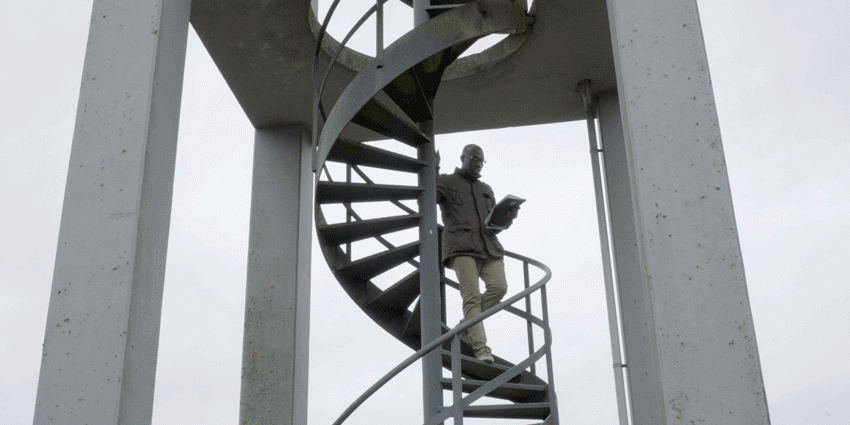ArtReview sent a questionnaire to artists and curators exhibiting in and curating the various national pavilions of the 2017 Venice Biennale, the responses to which will be published daily in the lead-up to the Venice Biennale opening (13 May – 26 November).
Wendelien van Oldenborgh is representing The Netherlands with Cinema Olanda. The pavilion is in the Giardini.
What can you tell us about your exhibition plans for Venice?
In the pavilion there will be an installation with architectural elements which somehow pay respect to the existing architecture by Gerrit Rietveld on the one hand, and on the other hand forces a new, or alternative angle into it. This installation is both functional for the light and sound conditions of the three new film works, and has an aesthetic relation with the content of these. The three films each have a different time-space-body relation with the viewer. One of them alluding to the ‘cinema’ as a space as well. All new works actively engage with the Netherlands as a country with a strong non-white community which has been asserting itself throughout the twentieth century and until now with an internationally connected cultural, political and social life. This aspect of the Netherlands has been persistently overshadowed by an image of homogeneity the country has been projecting. Lucy Cotter (the curator) and myself have started to think of the 1950s – when the Pavilion was built – as a period from which to look back and forth to the contemporary moment. This was the time when the Netherlands was re-imagining itself as a ‘modern nation’, progressive and transparent, like the architecture that still represents it. Not only does this image of a unified country, dedicated to progressiveness and transparency, clarity and straight lines no longer hold now: it was of course never true. Not in official culture, but also not in alternative (squatting) culture as one of the works, Prologue: Squat/Anti-Squat (2016) shows.
How is making a show for the Venice Biennale different to preparing a ‘normal’ exhibition? Or another biennial?
The fact alone that no matter how you turn it, it stays a ‘national representation’, makes for a very different approach and responsibilty. I mostly feel responsible for what I can do on this particular platform, to continue the work on the perception of what this nation is, and how is sees itself – on a much more visible scale than any other exhibition. Other biennials sometimes also give this opportunity of scale, but being in a ‘national pavilion’, literally a piece of Dutch ground in the middle of a park, next to a number of other nations presenting themselves in the same way, cannot be like any other show. We felt the exhibition had to address this. And therefore I am actually embracing this ‘national representation’ but understanding it as a moment in which I can represent something different than what has been the dominant image.
There are a huge number of biennial exhibitions across the world nowadays. Do you think the Venice Biennale still has a special status, and why?
Somehow it does still have a special status. Of course it is the oldest one, and it still manages to relate to the spirit with which it was inaugurated, which is the problematic side of course. Perhaps because no matter how much we don’t really want to, this element of ‘national representation’ is real.
What does it mean to ‘represent’ your country? Do you find it an honour or is it problematic?
Of course it is a mixture of those two. It is a huge honour to be the artist selected to perform this task this year in Venice, but we cannot – and don’t want to – take away the problematic side of this. I would like to ‘represent’ the Netherlands I see and know and get to know more by digging and making new connections. I am interested to see what I can do to make that image larger, broader, much more real. I am not so interested in ‘representing’ what is established as being ‘The Netherlands’ by those who have the power to do so. I hope I can manage not to be representing anything I don’t feel part of.
How does a having a pavilion in Venice make a difference to the art scene in your home country?
To be honest, I am not sure about that. There is this event and its particular space to think about for us, and the system in which it is being decided who is going to ‘play’ that space changes now and again, which always causes some stir and excitement. But would the art scene be different if there was no pavilion? We decided to organise an extensive parallel programme in various cultural venues in the Netherlands as an extension of the Venice exhibition because we wanted Cinema Olanda to have meaning in a national context.
You’ll no doubt be very busy, but what else are you looking forward to seeing?
It is a special year in Venice, since there are many very interesting artists representing their countries, like Jesse Jones in the Irish pavilion, Adelita Husni-Bey in the Italian pavilion, Jordi Colomer in the Spanish one – all artists I like to follow. In the main exhibition I also already very much look forward to new works which I know are being realised right now by Sung Hwan Kim for example and to discover what Christine Macel wanted to do with this show. And I am also looking forward to the special extra’s, like the show Space Force Construction, in the V-A-C Foundation’s new Venetian headquarters, where some nice artists like Christian Nyampeta are setting up very interesting live situations – and then there is the new initiative of the Diaspora pavilion. I am sure there will be much more I don’t yet know about, but would definitely like to see and experience.
Click here to read all the Venice Questionnaires so far
25 April 2017
